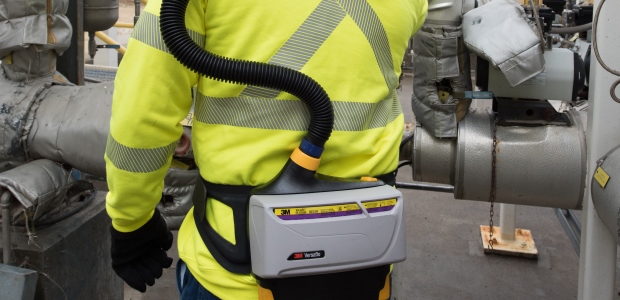
Why Pick a PAPR?
PAPRs are useful and often necessary in many types of hazardous jobs and conditions.
- By John J. Lenss
- May 01, 2019
Respiratory protection is a necessary part of many jobs throughout many different types of industries. Protecting workers from certain hazardous particulates, gases, vapors, and other contaminants is an important concern that should be top of mind.
Enter the powered air-purifying respirator, commonly referred to as a PAPR.1 OSHA defines this type of respiratory protection2 as an air-purifying respirator that uses a uses a battery-operated motor blower to pull ambient air through an air-purifying element to the inlet covering. A belt-mounted PAPR system typically includes a motor/blower, belt, filter/cartridge, battery, headgear, and a breathing tube.
Although there may be a higher capital expenditure when choosing to implement PAPRs into an employer’s respiratory protection program, this expense may be justified in the sense that PAPRs may:
- Eliminate fit testing if used with loose-fitting facepieces, hoods, or helmets
- Potentially increase comfort to the wearer
- Potentially integrate multiple types of PPE into one NIOSH-approved system (head, eye, face, and respiratory protection)
Moreover, some types of PAPRs are built to be intrinsically safe (IS), where certain work environments may require the use of electrical equipment that prevents ignition from the devices in certain hazardous atmospheres.
Now, let's explore some of the key benefits when it comes to selecting a PAPR system.
Easier Breathing
A PAPR system uses a blower instead of lung power to draw air through the filter. This allows the user to breathe comfortably with less resistance, as the airflow is delivered directly into the headgear from the blower.
No Fit Test Required for Loose-Fitting Headgear
Loose-fitting headgear on PAPRs do not require a fit test, unlike tight-fitting disposable and reusable air-purifying respirator options. This can potentially save time and money because fit testing takes time and must be performed at least annually in the United States.
Options for Use with Limited Facial Hair
With any tight-fitting respirator, beards and other facial hair can be a problem, compromising the face seal. But PAPR systems with loose-fitting headgear are designed to accommodate limited facial hair. This can allow workers to keep their facial hair in certain circumstances.
Integrated Eye Protection
Integrated faceshields on certain headgear for PAPR systems can help protect the eyes and face. At the same time, some headgear models may offer a wider field of vision, which can help the wearers easily view their surroundings.
Eyeglasses also may be worn under many loose-fitting headgear models.
Integrated PPE from the Neck Up
Non-integrated PPE from multiple manufacturers are often not designed to work as a cohesive "system." For example, you may wear a hard hat from Company A, eyewear made by Company B, respirator from Company C, and ear muffs sold by Company D. There are certain PAPR systems that include integrated hard hat protection, limited eye and face protection, and respiratory protection all incorporated into one system from the same manufacturer.
PAPR Systems Are Designed to Be Integrated and Work Together as a Single Unit
When using a PAPR approved by the National Institute for Occupational Safety and Health (NIOSH), the system is designed to work together as one integrated system. Further, certain PAPR systems may allow you to choose from a wide range of headgear, allowing for a customized PAPR solution that works for your environment.
For instance, certain PAPR blowers are compatible with both tight-fitting half-facepiece/full-facepiece respirators and loose-fitting headgear. In some instances, if you currently use a tight-fitting negative pressure respirator, a comparable PAPR system offering similar air-purifying filters/cartridges is also available. As with any respiratory protection product, proper care, cleaning, maintenance, and storage will help ensure optimal performance and durability. Of course, you need to make sure to read and follow the User Instructions for your particular PAPR model.
Certain work environments may require the use of electrical equipment that will prevent ignition in certain hazardous atmospheres. Electrical components of specific PAPR systems are available that meet certain intrinsic safety requirements. These systems provide respiratory protection while also helping to minimize the risk of ignition leading to a fire or explosion in hazardous environments.
High Levels of Protection
PAPRs configured with a loose-fitting facepiece offer an Assigned Protection Factor (APF) of 25. Respiratory hoods and helmets may have an APF up to 1,000; consult the manufacturer for details.
Protection for Professionals
PAPRs are useful and often necessary in many types of hazardous jobs and conditions—for instance, emergency workers such as first receivers who can help health care, military, and public health professionals during events such as natural disasters, mass casualties, or acts of terrorism.
PAPR systems also are available for first receiver, patient decontamination applications with specific systems approved to chemical, biological, radiological, and nuclear (CBRN) applications.
Before use, it is important to remember that the wearer must read and understand the User Instructions provided as a part of the product packaging. A written respiratory protection program also must be implemented that meets all of the requirements of 29 CFR 1910.134. To learn more about how to implement and manage a program, consult a Center for Respiratory Protection.3
References
1. https://www.3m.com/3M/en_US/company-us/all-3m-products/?N=5002385+8709322+8711017+8711405+8720539+8720547+3294857497&rt=r3
2. https://www.osha.gov/pls/oshaweb/owadisp.show_document?p_table=standards&p_id=12716
3. https://www.3m.com/3M/en_US/safety-centers-of-expertise-us/respiratory-protection/
This article originally appeared in the May 2019 issue of Occupational Health & Safety.